Spatiotemporal Evolution and Driving Factors of Land Development: Evidence from Shandong Province, China
Abstract
1. Introduction
2. Data
2.1. Overview of the Study Area
- (1)
- In 2019, Laiwu City withdrew from the central area and established its own districts, ultimately merging with Jinan City. Therefore, all data within the scope of the former Laiwu City during the study period have been categorized under Jinan City.
- (2)
- The study units for dividing a county into districts, removing a county-level city and establishing a district, and creating a county-level city by abolishing counties were mostly constant throughout the study period.
- (3)
- The module on the counties renamed during the study period remains unchanged.
- (4)
- Two counties were amalgamated into a new county. Due to a significant alteration in the study unit, data from the two previous counties were amalgamated into the new county’s dataset for the study period.
2.2. Sources of Data
2.3. Research Methods
2.3.1. Land Development Intensity Measurement Model
2.3.2. Analysis of Three-Dimensional Trend Surface
2.3.3. Analysis of Spatial Autocorrelation
2.3.4. Geodetector and Geographically Weighted Regression Models
3. Results
3.1. Pattern Evolution of Land Development Intensity
3.1.1. Overall Pattern Variation
3.1.2. Analysis of Three-Dimensional Trend Surface
3.1.3. Variation of Spatial Relationships
- (1)
- Global spatial autocorrelation
- (2)
- Local spatial autocorrelation
3.2. Driver Exploration
3.2.1. Impact Factor Identification
3.2.2. Influence Factor Interaction Detection
3.2.3. Spatial Heterogeneity of Drivers
4. Discussion
4.1. Analysis of Causes of Change
4.2. Recommendations for Land Development in the County
4.3. Research Limitations and Prospects
5. Conclusions
Author Contributions
Funding
Institutional Review Board Statement
Informed Consent Statement
Data Availability Statement
Acknowledgments
Conflicts of Interest
References
- Zhang, Q.; Yue, D.; Fang, M.; Yu, Q.; Huang, Y.; Su, K.; Ma, H.; Wang, Y. Study on sustainability of land resources in Dengkou County based on emergy analysis. J. Clean. Prod. 2018, 171, 580–591. [Google Scholar] [CrossRef]
- Cao, Y.; Zhang, X.; Zhang, X.; Li, H. The incremental construction land differentiated management framework: The perspective of land quota trading in China. Land Use Policy 2020, 96, 104675. [Google Scholar] [CrossRef]
- He, Z.; Ling, Y.; Fürst, C.; Hersperger, A.M. Does zoning contain built-up land expansion? Causal evidence from Zhangzhou City, China. Landsc. Urban Plan. 2022, 220, 104339. [Google Scholar] [CrossRef]
- Liu, Y.; Fang, F.; Li, Y. Key issues of land use in China and implications for policy making. Land Use Policy 2014, 40, 6–12. [Google Scholar] [CrossRef]
- Jiang, H.; Guo, H.; Sun, Z.; Xing, Q.; Zhang, H.; Ma, Y.; Li, S. Projections of urban built-up area expansion and urbanization sustainability in China’s cities through 2030. J. Clean. Prod. 2022, 367, 133086. [Google Scholar] [CrossRef]
- Gao, J.; Liu, Y.; Chen, Y. Land cover changes during agrarian restructuring in Northeast China. Appl. Geogr. 2006, 26, 312–322. [Google Scholar] [CrossRef]
- Ding, H.; Wang, R.-C.; Wu, J.-P.; Zhou, B.; Shi, Z.; Ding, L.-X. Quantifying Land Use Change in Zhejiang Coastal Region, China Using Multi-Temporal Landsat TM/ETM+ Images. Pedosphere 2007, 17, 712–720. [Google Scholar] [CrossRef]
- Zong, S.; Hu, Y.; Bai, Y.; Guo, Z.; Wang, J. Analysis of the distribution characteristics and driving factors of land use conflict potentials in the Bohai Rim coastal zone. Ocean Coast. Manag. 2022, 226, 106260. [Google Scholar] [CrossRef]
- Gong, J.; Chen, W.; Liu, Y.; Wang, J. The intensity change of urban development land: Implications for the city master plan of Guangzhou, China. Land Use Policy 2014, 40, 91–100. [Google Scholar] [CrossRef]
- Li, Y.; Chen, C.; Wang, Y.; Liu, Y. Urban-rural transformation and farmland conversion in China: The application of the environmental Kuznets Curve. J. Rural Stud. 2014, 36, 311–317. [Google Scholar] [CrossRef]
- Liu, J.; Liu, Y.; Yan, M. Spatial and temporal change in urban-rural land use transformation at village scale—A case study of Xuanhua district, North China. J. Rural Stud. 2016, 47, 425–434. [Google Scholar] [CrossRef]
- Wang, L.; Zhang, S.; Tang, L.; Lu, Y.; Liu, Y.; Liu, Y. Optimizing distribution of urban land on the basis of urban land use intensity at prefectural city scale in mainland China. Land Use Policy 2022, 115, 106037. [Google Scholar] [CrossRef]
- Zhang, B.; Li, W.; Zhang, C. Analyzing land use and land cover change patterns and population dynamics of fast-growing US cities: Evidence from Collin County, Texas. Remote Sens. Appl. Soc. Environ. 2022, 27, 100804. [Google Scholar] [CrossRef]
- Chen, W.; Zeng, J.; Li, N. Change in land-use structure due to urbanisation in China. J. Clean. Prod. 2021, 321, 128986. [Google Scholar] [CrossRef]
- Ge, W.; Xiaoqiu, L.; Yingjie, G.; Chen, Z.; Bingkun, W.; Xiangyu, L.; Xintong, L. How does land consolidation drive rural industrial development? Qualitative and quantitative analysis of 32 land consolidation cases in China. Land Use Policy 2023, 130, 106664. [Google Scholar]
- Wang, R.; Tan, R. Patterns of rural collective action in contemporary China: An archetype analysis of rural construction land consolidation. J. Rural Stud. 2020, 79, 286–301. [Google Scholar] [CrossRef]
- Dongdong, Y.; Xin, Z.; Anderson, B.C. Integrating Sponge City Requirements into the Management of Urban Development Land: An Improved Methodology for Sponge City Implementation. Water 2022, 14, 1156. [Google Scholar]
- Josip, K.; Miodrag, R. Development of a Methodology and Model for Land Administration Data Dissemination Processes. Land 2023, 12, 711. [Google Scholar]
- Ashish, G.; Piyush, T. An analysis of land and property development models, and stakeholders: A case of National Capital Region, India. Land Use Policy 2022, 117, 106110. [Google Scholar]
- Shen, Z.; Xu, X.; Xu, S.; Sun, D. A comparative study of land development patterns and regional thermal environments (RTEs) in typical urban agglomerations of China and America: A case study of Beijing-Tianjin-Hebei (BTH) and Boswash. Sci. Total Environ. 2022, 803, 149735. [Google Scholar] [CrossRef] [PubMed]
- Yanling, C.; Cuicui, T.; Qian, Z.; Wei, H.; Yongzheng, C. Analysis of land use/cover change in Guangdong-Hong Kong-Macao greater bay area from 1979 to 2016. Int. Conf. Environ. Remote Sens. Big Data 2021, 12129, 95–106. [Google Scholar]
- Zhou, Y.; Li, Y.; Xu, C. Land consolidation and rural revitalization in China: Mechanisms and paths. Land Use Policy 2020, 91, 104379. [Google Scholar] [CrossRef]
- Valtonen, E.; Falkenbach, H.; van der Krabben, E. Risk management in public land development projects: Comparative case study in Finland, and the Netherlands. Land Use Policy 2017, 62, 246–257. [Google Scholar] [CrossRef]
- O’Brien, P.; Lord, A.; Dembski, S. How do planners manage risk in alternative land development models? An institutional analysis of land development in the Netherlands. Land Use Policy 2020, 91, 104409. [Google Scholar] [CrossRef]
- Xin, H.; Xiaojun, H.; Mengmeng, L.; Bo, W.; Yonghua, Z. Spatial-temporal Dynamics and Driving Forces of Land Development Intensity in the Western China from 2000 to 2015. Chin. Geogr. Sci. 2020, 30, 16–29. [Google Scholar]
- Tan, S.; Liu, Q.; Han, S. Spatial-temporal evolution of coupling relationship between land development intensity and resources environment carrying capacity in China. J. Environ. Manag. 2022, 301, 113778. [Google Scholar] [CrossRef]
- Tang, J.; Gao, H.; Song, X.; Xu, H. Convergence or divergence between small towns and villages: A perspective from changes in built-up land development intensity. Habitat Int. 2023, 138, 102874. [Google Scholar] [CrossRef]
- Zaiyan, L.; Peiji, S. Analysis of changes in spatial pattern of development intensity of urban and rural construction land in Lanzhou-Xining urban agglomeration and the factors affecting it. J. Ecol. Rural. Environ. 2020, 36, 450–458. (In Chinese) [Google Scholar]
- Wellmann, T.; Haase, D.; Knapp, S.; Salbach, C.; Selsam, P.; Lausch, A. Urban land use intensity assessment: The potential of spatio-temporal spectral traits with remote sensing. Ecol. Ind. 2018, 85, 190–203. [Google Scholar] [CrossRef]
- Ferdous, N.; Bhat, C.R. A spatial panel ordered-response model with application to the analysis of urban land-use development intensity patterns. J. Geogr. Syst. 2013, 15, 1–29. [Google Scholar] [CrossRef]
- Li, Z.; Yu, X.; Gong, C. Intensity Change in Cultivated Land Use in Shandong Province from 1980 to 2010. IERI Procedia 2013, 5, 140–146. [Google Scholar] [CrossRef]
- Li, X.; Wu, K.; Yang, Q.; Hao, S.; Feng, Z.; Ma, J. Quantitative assessment of cultivated land use intensity in Heilongjiang Province, China, 2001–2015. Land Use Policy 2023, 125, 106505. [Google Scholar] [CrossRef]
- Zhang, P.; Yang, D.; Qin, M.; Jing, W. Spatial heterogeneity analysis and driving forces exploring of built-up land development intensity in Chinese prefecture-level cities and implications for future Urban Land intensive use. Land Use Policy 2020, 99, 104958. [Google Scholar] [CrossRef]
- Di, X.; Hou, X.; Wang, Y.; Wu, L. Spatial-temporal Characteristics of Land Use Intensity of Coastal Zone in China during 2000–2010. Chin. Geogr. Sci. 2015, 25, 51–61. [Google Scholar] [CrossRef]
- Xie, W.; Jin, W.; Chen, K.; Wu, J.; Zhou, C. Land Use Transition and Its Influencing Factors in Poverty-Stricken Mountainous Areas of Sangzhi County, China. Sustainability 2019, 11, 4915. [Google Scholar] [CrossRef]
- Xiao, Y.; Gong, P. Removing spatial autocorrelation in urban scaling analysis. Cities 2022, 124, 103600. [Google Scholar] [CrossRef]
- Xu, F.; Wang, Z.; Chi, G.; Zhang, Z. The impacts of population and agglomeration development on land use intensity: New evidence behind urbanization in China. Land Use Policy 2020, 95, 104639. [Google Scholar] [CrossRef]
- Chufu, M.; Limao, W.; Qiushi, Q.; Yebing, F.; Hong, Z. Factors Driving the Expansion of Construction Land: A Panel Data Study of Districts and Counties in Ningbo City, China. J. Resour. Ecol. 2018, 9, 365–373. [Google Scholar] [CrossRef]
- Ouyang, D.; Zhu, X.; Liu, X.; He, R.; Wan, Q. Spatial Differentiation and Driving Factor Analysis of Urban Construction Land Change in County-Level City of Guangxi, China. Land 2021, 10, 691. [Google Scholar] [CrossRef]
- Li, Y.; Li, Y.; Karácsonyi, D.; Liu, Z.; Wang, Y.; Wang, J. Spatio-temporal pattern and driving forces of construction land change in a poverty-stricken county of China and implications for poverty-alleviation-oriented land use policies. Land Use Policy 2020, 91, 104267. [Google Scholar] [CrossRef]
- Liu, Z.; Chen, J.; Ni, J.; Zhang, L. Restriction Analysis of Residual Capacity of Intersection on Land Development Intensity. J. Transp. Syst. Eng. Inf. Technol. 2011, 11, 73–78. [Google Scholar] [CrossRef]
- Cao, R.-f.; Zhang, A.-l.; Cai, Y.-y.; Xie, X.-x. How imbalanced land development affects local fiscal condition? A case study of Hubei Province, China. Land Use Policy 2020, 99, 105086. [Google Scholar] [CrossRef]
- Xu, Y.; Tang, Q.; Fan, J.; Bennett, S.J.; Li, Y. Assessing construction land potential and its spatial pattern in China. Landsc. Urban Plan. 2011, 103, 207–216. [Google Scholar] [CrossRef]
- Jinfeng, W.; Chengdong, X. Geoprobes: Principles and Prospects. J. Geogr. 2017, 72, 116–134. (In Chinese) [Google Scholar]
- Propastin, P. Modifying geographically weighted regression for estimating aboveground biomass in tropical rainforests by multispectral remote sensing data. Int. J. Appl. Earth Obs. Geoinf. 2012, 18, 82–90. [Google Scholar] [CrossRef]
- Jing, H.; Yang, R.; Kun, Y.; Wei, L.; Teng, M. Quantitative attribution of key town layout in China based on geodetector and GWR model. Adv. Geosci. 2020, 39, 1687–1697. (In Chinese) [Google Scholar]
- Xinjian, D.; Junhai, M. Study on the Indicator System for Evaluating Economic Development Efficiency in Shandong Province. Energy Procedia 2011, 5, 900–904. [Google Scholar] [CrossRef][Green Version]
- Yanjun, L.; Huisheng, Y.; Degang, L.; Liyuan, Z. Mechanisms of spatial differentiation in the evolution of construction land development intensity patterns in Northeast China. J. Geogr. 2018, 73, 818–831. (In Chinese) [Google Scholar]
- Chen, J.; Gao, J.; Chen, W. Urban land expansion and the transitional mechanisms in Nanjing, China. Habitat Int. 2016, 53, 274–283. [Google Scholar] [CrossRef]
- Ding, C.; Lichtenberg, E. Land and Urban economic growth in China. J. Reg. Sci. 2011, 51, 299–317. [Google Scholar] [CrossRef]
- Li, H.; Wei, Y.D.; Liao, F.H.; Huang, Z. Administrative hierarchy and urban land expansion in transitional China. Appl. Geogr. 2015, 56, 177–186. [Google Scholar] [CrossRef]
- Lin, G.C.S. Toward a post-socialist city? Economic tertiarization and urban reformation in the Guangzhou Metropolis, China. Eurasian Geogr. Econ. 2004, 45, 18–44. [Google Scholar] [CrossRef]
- Shi, S.; Chen, Z.H.; Qi, J.; Liu, Y. Characteristics of Landscape (Land Use) Change and its Driving Force in County—A Case Study of Shunyi District of Beijing. Appl. Mech. Mater. 2014, 692, 115–120. [Google Scholar] [CrossRef]
- Qiao, W.; Huang, X. How does transportation development affect environmental performance? Evidence from Hainan Province, China. Cities 2022, 129, 103835. [Google Scholar] [CrossRef]
- Liu, H.; Zheng, M.; Liu, J.; Zheng, X. Sustainable land use in the trans-provincial marginal areas in China. Resour. Conserv. Recycl. 2020, 157, 104783. [Google Scholar] [CrossRef]
- Fang, G.; Yang, J.; Su, H.M. Dynamic Analysis of Land Use/Cover Change in Dangshan County. Adv. Mater. Res. 2011, 356–360, 2874–2879. [Google Scholar] [CrossRef]
- Dekun, D.; Jinping, L.; Shuzhong, G. Expansion and Change of Rural Settlements in Traditional Agricultural Regions: Based on Village Investigation in Pingdu County. Chin. J. Popul. Resour. Environ. 2008, 6, 55–61. [Google Scholar] [CrossRef]
- Wang, S.; Fang, C.; Wang, Y.; Huang, Y.; Ma, H. Quantifying the relationship between urban development intensity and carbon dioxide emissions using a panel data analysis. Ecol. Ind. 2015, 49, 121–131. [Google Scholar] [CrossRef]
- Qingke, Y.; Lei, W.; Yongle, L.; Yeting, F.; Chao, L. Urban land development intensity: New evidence behind economic transition in the Yangtze River Delta, China. J. Geogr. Sci. 2022, 32, 2453–2474. [Google Scholar]
- Guanhai, G.; Bin, W.; Wenzhu, Z.; Rucheng, L.; Xiaoling, F.; Wenhui, L.; Caiping, P.; Shengquan, L. Comparing machine learning methods for predicting land development intensity. PLoS ONE 2023, 18, e0282476. [Google Scholar]
- Fengying, L.; Zhiqiang, P.; Guangyao, D. Study on the Measurement of the Level of Rural Revitalization and Spatial Correlation Effect--Taking Gansu Province as an Example. Stat. Decis. Mak. 2022, 38, 63–68. (In Chinese) [Google Scholar]
- Wang, Y.; Li, L. Forecasts of Urban Construction Land Scale based on Driving Force Analysis. In Proceedings of the 2017 5th International Conference on Mechatronics, Materials, Chemistry and Computer Engineering (ICMMCCE 2017), Chongqing, China, 24–25 July 2017. [Google Scholar]
- Jin, X.; Zhang, H.; Zhou, Y. Comparison analysis of agricultural land gradation evaluation based on different weight making methods. Geoinformatics 2008, 7145, 225–233. [Google Scholar]
- Ripley, B.D. Spatial Processes: Models and Applications. J. Am. Stat. Assoc. 1984, 79, 238. [Google Scholar] [CrossRef]
- Kumari, M.; Sarma, K.; Sharma, R. Using Moran’s I and GIS to study the spatial pattern of land surface temperature in relation to land use/cover around a thermal power plant in Singrauli district, Madhya Pradesh, India. Remote Sens. Appl. Soc. Environ. 2019, 15, 100239. [Google Scholar] [CrossRef]
- Rossi, R.E.; Mulla, D.J.; Journel, A.G.; Franz, E.H. Geostatistical Tools for Modeling and Interpreting Ecological Spatial Dependence. Ecol. Monogr. 1992, 62, 277–314. [Google Scholar] [CrossRef]
- Zhao, R.; Zhan, L.; Yao, M.; Yang, L. A geographically weighted regression model augmented by Geodetector analysis and principal component analysis for the spatial distribution of PM2.5. Sustain. Cities Soc. 2020, 56, 102106. [Google Scholar] [CrossRef]
- Jiang, H.; Yin, J.; Qiu, Y.; Zhang, B.; Ding, Y.; Xia, R. Industrial Carbon Emission Efficiency of Cities in the Pearl River Basin: Spatiotemporal Dynamics and Driving Forces. Land 2022, 11, 1129. [Google Scholar] [CrossRef]
- Huang, H.; Zhou, Y.; Qian, M.; Zeng, Z. Land Use Transition and Driving Forces in Chinese Loess Plateau: A Case Study from Pu County, Shanxi Province. Land 2021, 10, 67. [Google Scholar] [CrossRef]
- Brunsdon, C.; Fotheringham, A.S.; Charlton, M.E. Geographically Weighted Regression: A Method for Exploring Spatial Nonstationarity. Geogr. Anal. 1996, 28, 281–298. [Google Scholar] [CrossRef]
- Siyu, L.; Jinyan, Z.; Zhaopeng, W. A study of oasis land use and its spatial conflict in Jinghe County. J. Ecol. Rural. Environ. 2022, 38, 428–436. (In Chinese) [Google Scholar]
- Jinghu, P.; Ying, L. Spatial Field Energy Measurement of Chinese Cities Above Prefecture Level Based on Accessibility and Field Strength Modeling. Hum. Geogr. 2014, 29, 80–88. (In Chinese) [Google Scholar]
- Hadiyanto; Dety Novia Utami, N.; Supriatna, S.; Anggrahita, H.; Maryono; Warsito, B. Multi Criteria Analysis of Built-Up Land Suitability in Sleman Regency, Special Region of Yogyakarta Province. E3S Web Conf. 2018, 73, 03005. [Google Scholar]
- Zhang, W.; Shi, P.; Tong, H. Research on Construction Land Use Benefit and the Coupling Coordination Relationship Based on a Three-Dimensional Frame Model—A Case Study in the Lanzhou-Xining Urban Agglomeration. Land 2022, 11, 460. [Google Scholar] [CrossRef]
- Fang, L.; Tian, C. Construction land quotas as a tool for managing urban expansion. Landsc. Urban Plan. 2020, 195, 103727. [Google Scholar] [CrossRef]
- Krejčí, T.; Dostál, I.; Havlíček, M.; Martinát, S. Exploring the hidden potential of sugar beet industry brownfields (case study of the Czech Republic). Transp. Res. Part DTransp. Environ. 2016, 46, 284–297. [Google Scholar] [CrossRef]
- Wang, H.; Shen, Q.; Tang, B.-S.; Skitmore, M. An integrated approach to supporting land-use decisions in site redevelopment for urban renewal in Hong Kong. Habitat Int. 2013, 38, 70–80. [Google Scholar] [CrossRef]
- Wang, Y.; Zhu, X.; Li, L.; Wu, B. Reasons and Countermeasures of Traffic Congestion under Urban Land Redevelopment. Procedia-Soc. Behav. Sci. 2013, 96, 2164–2172. [Google Scholar] [CrossRef][Green Version]
- Zhou, Y.; Huang, X.; Zhong, T.; Chen, Y.; Yang, H.; Chen, Z.; Xu, G.; Niu, L.; Li, H. Can annual land use plan control and regulate construction land growth in China? Land Use Policy 2020, 99, 105026. [Google Scholar] [CrossRef]
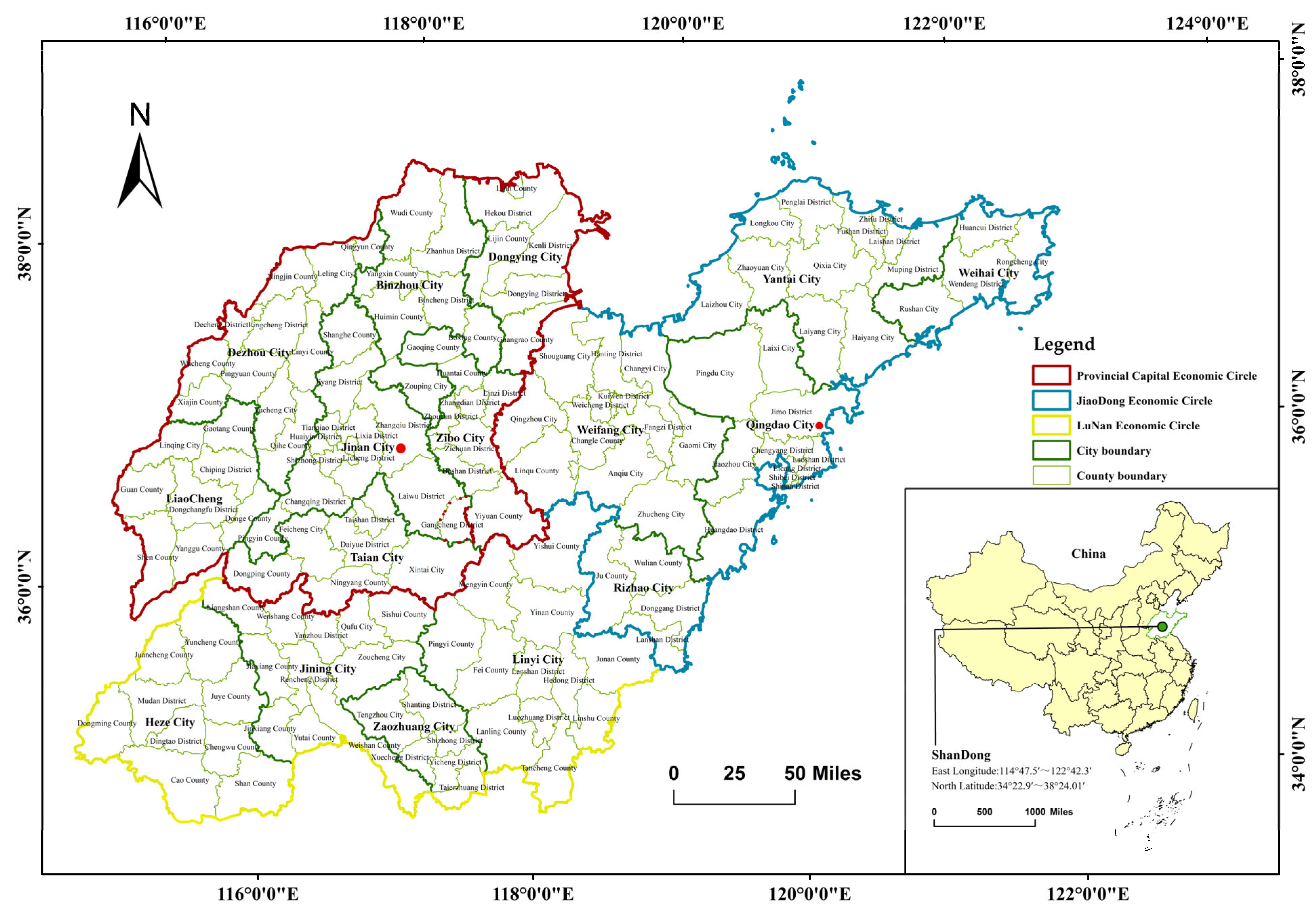

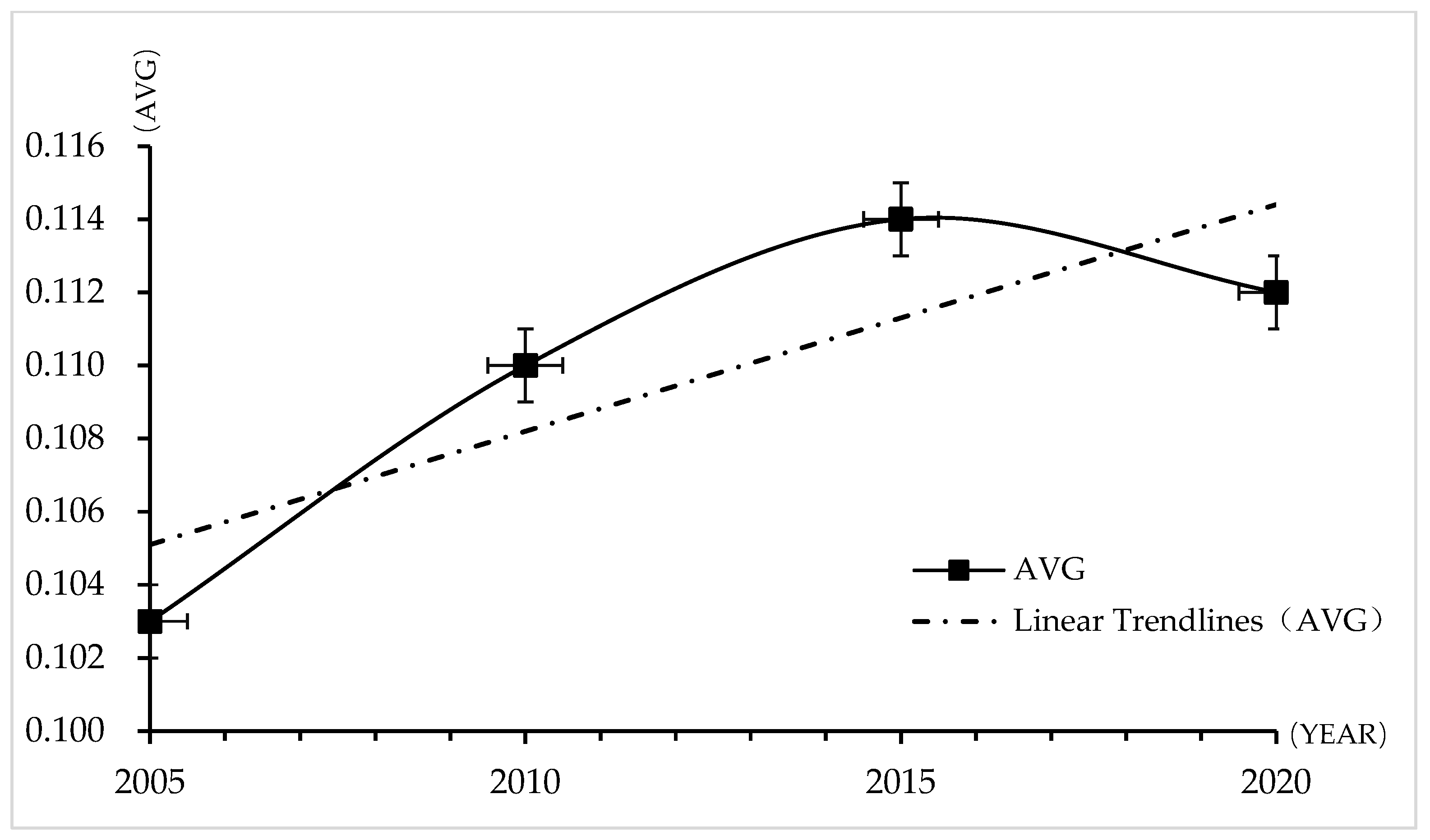
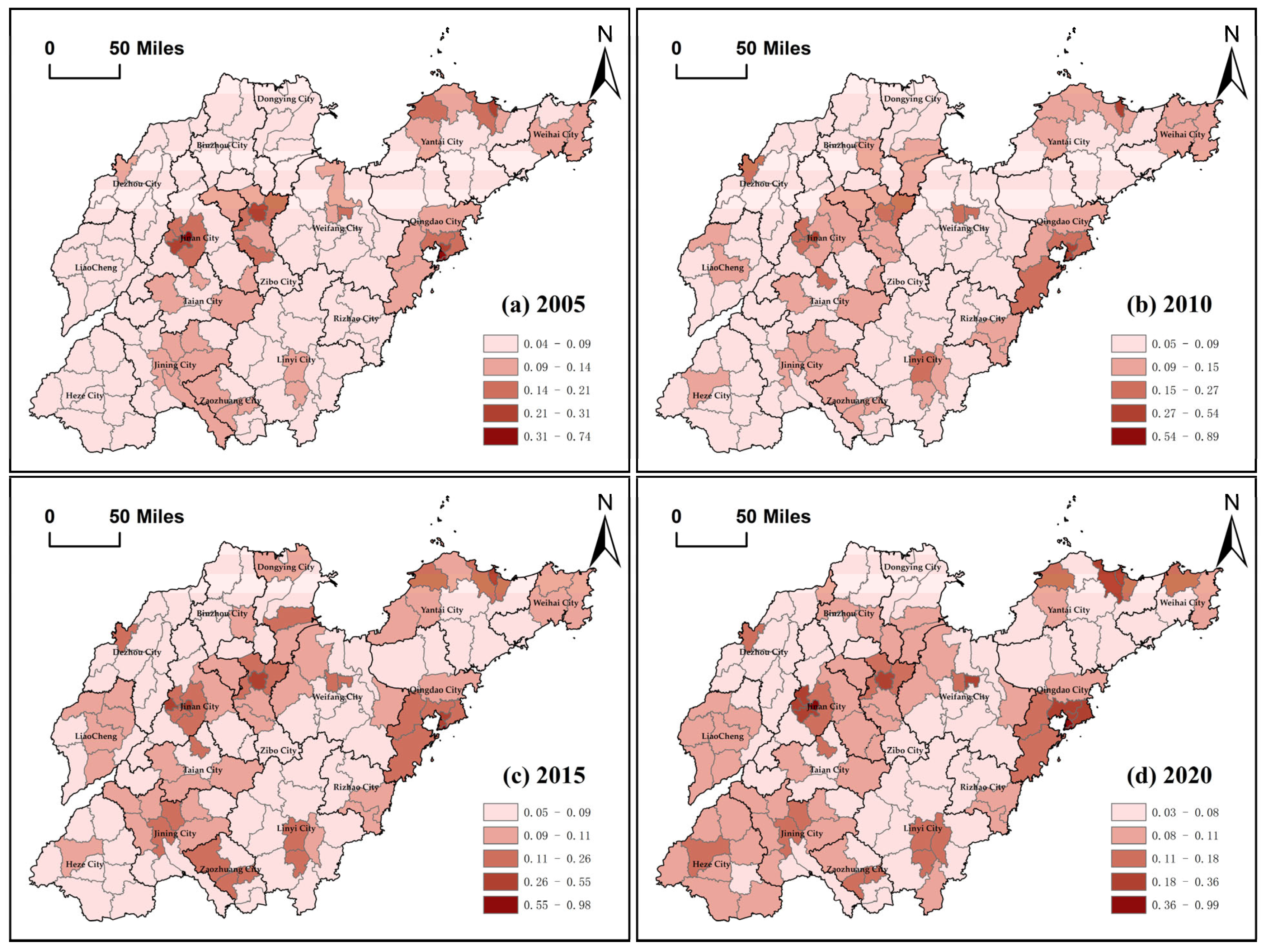


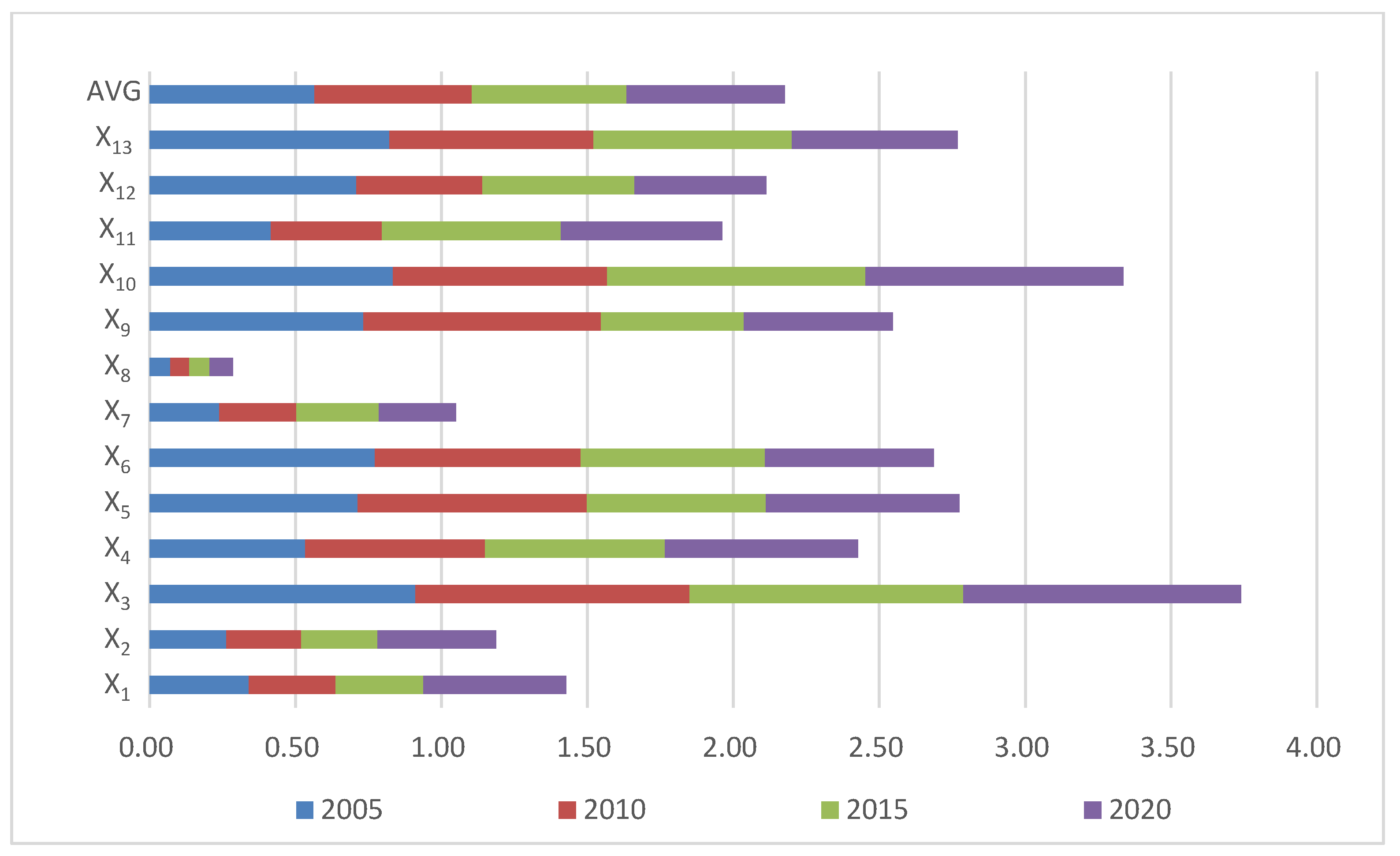
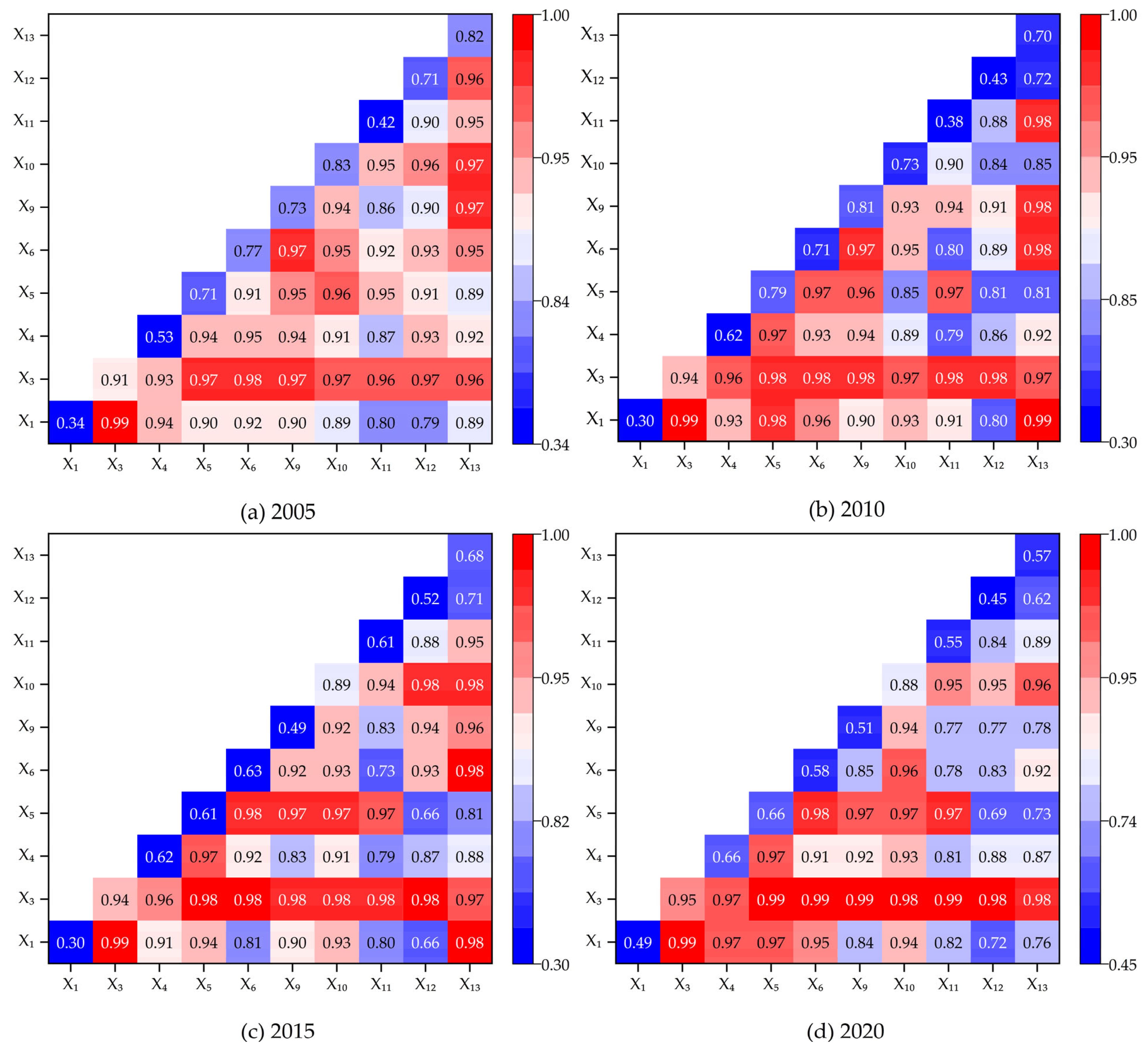
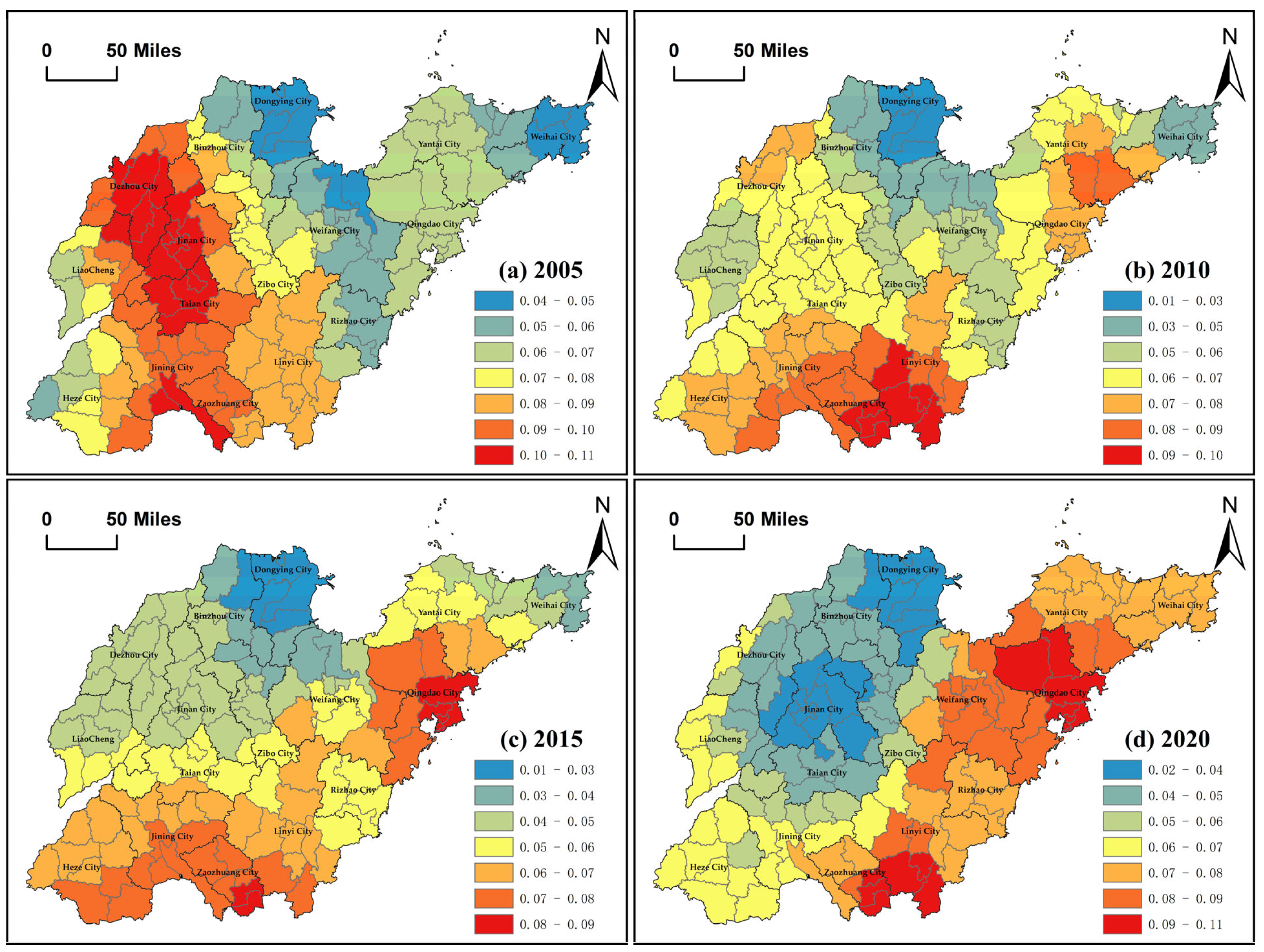

| Modul | No. | Indicator Title | Property | Indicator Interpretation | Main Data Sources |
|---|---|---|---|---|---|
| development intensity | 1 | DLA | + | Development land area | Centre for Resource and Environmental Sciences and Data, Chinese Academy of Sciences, National Geographic Information Resources Catalogue Service System |
| 2 | TA | + | Total area | ||
| 3 | RP | + | Regional population | China County Statistical Yearbook, Shandong Statistical Yearbook, Shandong Yearbook | |
| 4 | OV | + | Output value | ||
| driving factors | X1 | GDP per capita | + | Socio-economic development | |
| X2 | GDP per sq. km. | + | |||
| X3 | Population density | + | Population agglomeration | ||
| X4 | Per capita land development and utilization area | + | China County Statistical Year-book, Centre for Resource and Environmental Sciences and Data, Chinese Academy of Sciences, National Geographic Information Resources Catalogue Service System | ||
| X5 | Total retail sales of consumer goods per capita | + | Residents’ financial capability | China County Statistical Year-book, Statistical yearbook of each city, official website of each city statistical office | |
| X6 | Per capita urban and rural residents’ savings deposit balance | + | |||
| X7 | Topographic relief | − | Terrain conditions | Geospatial data cloud, National Geographic Information Resources Catalogue Service System | |
| X8 | Average elevation | − | |||
| X9 | Completed fixed asset investment per sq. km. | + | Investment intensity | China County Statistical Year-book, Shandong Statistical Year-book, Shandong Yearbook, Statistical yearbook of each city, official website of each city statistical office | |
| X10 | Public finance budget expenditure per sq.km. | + | |||
| X11 | Gross exports per sq. km. | + | Openness | ||
| X12 | Share of secondary and tertiary industries | + | Industrial structure quality | China County Statistical Year-book, Shandong Statistical Year-book, Shandong Yearbook | |
| X13 | Cultivated land area per capita | − | Natural resource conditions | Centre for Resource and Environmental Sciences and Data, Chinese Academy of Sciences, National Geographic Information Resources Catalogue Service System, China County Statistical Year-book |
| Parameters | 2005 | 2010 | 2015 | 2020 |
|---|---|---|---|---|
| Moran’s I Index | 0.51 | 0.43 | 0.42 | 0.45 |
| Z Score | 10.49 | 9.16 | 9.27 | 9.56 |
| p-value | 0.00 | 0.00 | 0.00 | 0.00 |
Disclaimer/Publisher’s Note: The statements, opinions and data contained in all publications are solely those of the individual author(s) and contributor(s) and not of MDPI and/or the editor(s). MDPI and/or the editor(s) disclaim responsibility for any injury to people or property resulting from any ideas, methods, instructions or products referred to in the content. |
© 2023 by the authors. Licensee MDPI, Basel, Switzerland. This article is an open access article distributed under the terms and conditions of the Creative Commons Attribution (CC BY) license (https://creativecommons.org/licenses/by/4.0/).
Share and Cite
Zhao, C.; Geng, R.; Liu, J.; Peng, L.; Yamaka, W. Spatiotemporal Evolution and Driving Factors of Land Development: Evidence from Shandong Province, China. Sustainability 2023, 15, 15069. https://doi.org/10.3390/su152015069
Zhao C, Geng R, Liu J, Peng L, Yamaka W. Spatiotemporal Evolution and Driving Factors of Land Development: Evidence from Shandong Province, China. Sustainability. 2023; 15(20):15069. https://doi.org/10.3390/su152015069
Chicago/Turabian StyleZhao, Chuansong, Ran Geng, Jianxu Liu, Liuying Peng, and Woraphon Yamaka. 2023. "Spatiotemporal Evolution and Driving Factors of Land Development: Evidence from Shandong Province, China" Sustainability 15, no. 20: 15069. https://doi.org/10.3390/su152015069
APA StyleZhao, C., Geng, R., Liu, J., Peng, L., & Yamaka, W. (2023). Spatiotemporal Evolution and Driving Factors of Land Development: Evidence from Shandong Province, China. Sustainability, 15(20), 15069. https://doi.org/10.3390/su152015069





